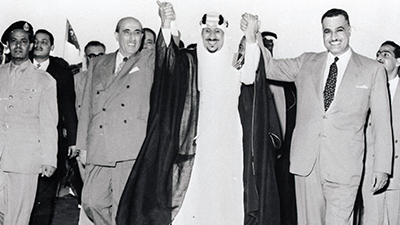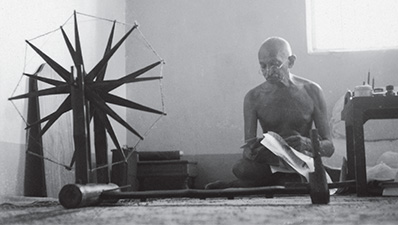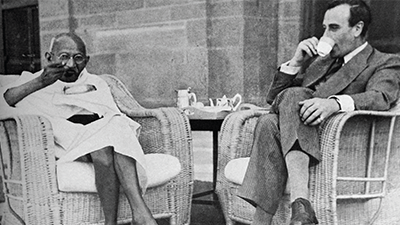Decolonization After 1900
Driving Question: What strategies and ideologies have been shared in common by liberation movements in different parts of the world?
Revolution and global pressure pushed massive changes forward after World War II. This lesson features powerful voices of decolonization often left out of the story for a fuller view of the end of empire.
Learning Objectives
- Compare the processes by which various peoples pursued independence after 1900.
- Use graphic biographies to support, extend, or challenge the overarching narratives from this region.
Vocab Terms:
- boycott
- decolonization
- mandate
- massacre
- nationalist
- nonviolence
- protectorate
Opener: Decolonization After 1900
To teach this lesson step, refer to page 3 of the Lesson 8.5 Teaching Guide.
One salty image will help you start to consider the connected struggles for independence and equality in this period.
The Middle East and the End of Empire
To teach this lesson step, refer to page 3 of the Lesson 8.5 Teaching Guide.
Communities in the Middle East hoped for independence from their respective colonial powers after World War II. However, the Cold War conflict between the United States and Soviet Union only produced further foreign interference in many nations in the region.
-
Guiding Questions
-
Before you read
Preview the questions below, and then skim the article. Be sure to look at the section headings and any images.
While you read
Look for answers to these questions:
- Where does the term “Middle East” come from? What countries does the region include?
- What was the Sykes–Picot Agreement?
- Why was the Suez Canal important?
- What did Gamal Nasser do to provoke invasion by the British, French, and Israelis? How was the invasion stopped?
- What policy did Mohammad Mossadegh implement in Iran? Why did he take these actions and what was the result?
After you read
Respond to the following questions:
- Using evidence from this article, explain the economic changes and continuities resulting from the process of decolonization.
- Nasser and Mossadegh both nationalized important resources in their countries. They both challenged British economic imperialism. But their efforts had two very different outcomes. What do you think explains these two different outcomes?
And Then Gandhi Came: Nationalism, Revolution, and Sovereignty
To teach this lesson step, refer to page 5 of the Lesson 8.5 Teaching Guide.
What are the features of successful independence movements, and how and why do these revolutions happen? The Quit India movement, led by the inspirational lawyer Mohandas Gandhi, is a case study of how a nonviolent revolution can succeed in its goals.
-
Guiding Questions
-
Before you read
Preview the questions below, and then skim the article. Be sure to look at the section headings and any images.
While you read
Look for answers to these questions:
- What does historian Benedict Anderson mean when he describes the nation as an imagined community?
- Describe Gandhi’s vision of India as a new nation. What different classes of people would need to come together to realize this vision?
- Why did the Amritsar massacre galvanize the anti-colonial movement in India? How did Indians’ desire for dignity in the face of humiliation by colonial officials fuel the movement?
- What is satyagraha and how was it an anti-colonial strategy for challenging and winning power?
- What role did community play in Indian protests and boycotts of colonial goods?
After you read
Respond to the following questions:
- To what extent does this article explain various reactions to existing power structures in the period after 1900?
- How did Gandhi inspire Indians with his guiding philosophy and his imagined nation-state?
- Consider Gandhi’s vision in the context of historian Benedict Anderson’s definition of nationalism. How does the “imagined community” extend your understanding of the cultural developments and interactions theme narrative?
- Historian Benedict Anderson describes how millions of people have willingly died for the idea of a nation, an idea constructed in their imaginations. What do you believe a nation is? What characteristics and shared beliefs and values set your nation apart and define it? What sacrifices would you be willing to make for your nation?
Resisting Colonialism: Through a Ghanaian Lens
To teach this lesson step, refer to page 6 of the Lesson 8.5 Teaching Guide.
Looking for more support using video in the classroom? Check out the blog post Engaging students with video.
We often think of resistance to colonialism in terms of armies and battles, and many independence struggles involved conflict. But resistance can also take many other forms—as seen in the case of the Gold Coast, better known today as Ghana.
-
Guiding Questions
-
Before you watch
Preview the questions below, and then review the transcript.
While you watch
Look for answers to these questions:
- What did Ghanaian historian A. Adu Boahen mean when he said, “Independence was not given on a silver platter but won by blood”?
- Who was Yaa Asantewaa, and why was she famous?
- What was the Golden Stool of Asante? Why did the British want it? Did they get it in the end?
- Why, according to Tony Yeboah, was a lot of anti-colonial resistance actually aimed at chiefs and kings?
- What kind of resistance did the UGCC (United Gold Coast Convention) organize after the Second World War?
- Why did Ghanaian veterans, who had fought for Britain during the war, march in 1947, and what happened to them?
- What was Kwame Nkrumah’s strategy of positive action? Why was he such an effective leader, according to Tony Yeboah?
After you watch
Respond to the following questions:
- Using evidence from this article, compare the processes by which various peoples pursued independence after 1900.
- This video focuses on some big acts of resistance. Do you think these acts represent most common forms of resistance? If not, what is missing? If so, what evidence supports your argument?
Key Ideas
Comparison: Decolonization Methods
To teach this lesson step, refer to page 8 of the Lesson 8.5 Teaching Guide.
Students have worked hard on comparison all year, help check their progress by evaluating this assignment using the Comparison Feedback Form.
You’ve learned about decolonization efforts in India, Ghana, and Egypt. Compare and contrast what these methods look like in these regions.
-
Guiding Questions
-
Before you read
Preview the questions below, and then skim the article. Be sure to look at the section headings and any images.
While you read
Look for answers to these questions:
- What was the necessary condition for a colonized people to end colonial rule? Why?
- What ideologies helped people resist colonial rule?
- How did anti-colonial struggles attempt to change the mindset of their colonizers? What regions were more successful?
- Which of these four nations engaged in violent struggles? Which attempted nonviolence? Were their outcomes different?
- What happened to the nationalist movements’ unity after achieving independence?
After you read
Respond to this question: All four of the nations compared in this article were successful at ending colonial rule and all are independent today. What do you think are the most important similarities among all four that help explain this success?
Graphic Biography: Kwame Nkrumah
To teach this lesson step, refer to page 14 of the Lesson 8.5 Teaching Guide.
Curious how well your students are comprehending Graphic Biographies? Use the Three-Step Reading for Graphic Biographies: Tool to help evaluate their understanding.
How did the man who led a successful movement for independence in Ghana become involved in diplomacy during the Cold War? Kwame Nkrumah’s biography provides evidence to help you to evaluate the connections between decolonization and the Cold War.
-
Guiding Questions
-
Before you read
Preview the questions below, and then skim the comic, paying attention to things like prominent colors, shapes, and types of text and fonts. How do you know where to start and in which direction to read? What’s in the gutters (the space between panels)? Who or what is the focus of the comic?
While you read
Look for answers to these questions:
- Where was Nkrumah born and where was he educated?
- Why was his education in Pennsylvania important?
- In 1957, Nkrumah became the first President of Ghana. Given the quote in this biography, why did he believe that he had to support independence movements elsewhere, and how did he do it?
- How did his international efforts play a role in his overthrow in 1966?
- How does the artist use art and design to portray Nkrumah’s role in international anti-colonialism?
After you read
Respond to the following questions:
- Using evidence from this comic, compare the processes by which various peoples pursued independence after 1900.
- How does this biography of Kwame Nkrumah support, extend, or challenge what you have learned about the Cold War and decolonization?
Closer: Decolonization After 1900
You’ve just learned a lot about decolonization. You could probably write a book, or at least an essay…but let’s start with one page.
Decolonization and Nationalism Triumphant: Crash Course World History #40
To teach this lesson step, refer to page 15 of the Lesson 8.5 Teaching Guide.
The end of World War II brought about various nationalist and independence movements around the world.
-
Guiding Questions
-
Before you watch
Preview the questions below, and then review the transcript.
While you watch
Look for answers to these questions:
- How did World War II affect colonial empires?
- Why was there tension within India’s independence movement? What was the source of the disagreement?
- In what way was the Indian independence movement very different from the partition of India that followed? What do you think was the cause of this difference?
- What are cash crops? How were Indonesian farmers exploited in order to enrich the Netherlands?
- What kinds of challenges did African nations face after independence? How had imperialism contributed to those challenges?
After you watch
Respond to the following questions:
- Use evidence from this video to compare the processes by which various peoples pursued independence after 1900.
- What factors made it possible for anti-colonial movements around the world to achieve independence during this period? Why did some factors have more influence on certain former colonies and less on others?
- Was violence necessary to achieve independence? Examine the role that violence played in the various parts of the world that John Green covers. Based on the information you have so far, do you think independence could have been achieved solely through nonviolent resistance?







